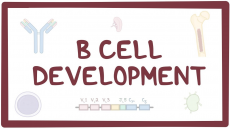

B cell development
The immune system can be divided into two parts; the innate and the adaptive immune system. The innate immune system is the bodies first line of defence. It is not specific and works the same for all pathogens. It begins with pathogen entry past the bodies primary defences such as chemical and physical barriers. The innate response is necessary to activate the adaptive immune response. The adaptive response takes some time to develop, this is because it is a specific response that is different depending on the invading pathogen.
What are B cells?
B cells are B lymphocytes part of the adaptive immune response. They are responsible for producing antibodies against pathogens through dividing into plasma cells, and they create a memory of these pathogens through differentiating into memory B cells. Making memory B cells means that if your body is faced with a pathogen it has already seen before, then it knows how to respond quickly, and efficiently.
Mature B cells are called plasma cells. So, remember, the antigen (on a pathogen) can bind to a B cell. The B cell sees the antigen in its 3-dimensional shape, unlike T lymphocytes. The B cell can then engulf the antigen by receptor mediated endocytosis, and then become an antigen presenting cell by presenting the antigen on an MHC molecule. A MHC molecule is a Major Histocompatibility Complex which presents antigen 2-dimensionally, presenting the antigen to T cells to activate them. This presentation allows for T helper cells to bind, see the antigen then release signals to activate the B cell. So in order to activate B cells, T cells need to be activated.
In development, the cell begins as a stem cell, it is not specialised to a particular function. At each stage cells lose plasticity, because they are less capable of differentiating into any type of cell, and so become more restricted as to what they can become.
The early stages of development are dependent on adhesion molecules and cytokines, messages are going back and forward from the stromal bone marrow cell and the stem cell. FLT3 receptor on the stem cell binds to ligand on the stromal cell to keep the cell within close association. The notch pathway determines whether the cell is going down the B cell or T cell route. With certain IL and adhesion molecules the cell decides to go down the B cell route (early pro b cell.) IL-7 plays an important role in bringing the cell to the late pro-B cell stage. At the pre-B cell stage, genes have been rearranged allowing BCR to be expressed. More interaction with cell adhesion molecules and IL-7 drives the production of immature B cells.
The B cell enters through the high endothelial venule, this is a T cell zone, so it can interact with any antigen that’s been presented. B cells that have been activated start to release IgM, and then migrate into the b cell follicles (the germinal cells), so they can proliferate.
image-https://www.osmosis.org/learn/B_cell_development

0 Comment:
Be the first one to comment on this article.